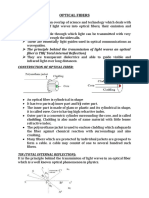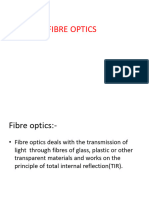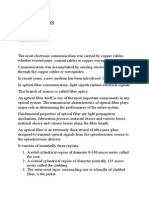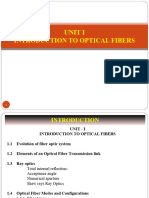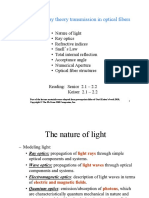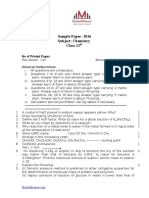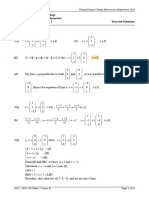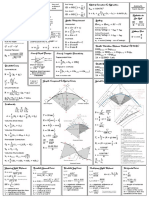Module 1.
Sample: Explain the following in the context of optical fiber using the appropriate
diagrams: a) Critical angle, b) Working principle, and its c) Structure.
a) Critical angle: When a ray of light travels from denser to rarer medium it bends
away from the normal. As the angle of incidence increases in the denser medium,
the angle of refraction also increases. For a particular angle of incidence the
refracted ray grazes the surface separating the media or the angle of refraction is
equal to 90° this angle is called the “critical angle” (θc). ……………..(2 Marks)
Diagram……………(1 Marks)
b) Working principle: If the angle of incidence is further increased beyond the
critical angle, the light ray is reflected back to the same medium. This is called
“Total Internal Reflection”. In total internal reflection, there is no loss of energy.
The entire incident ray is reflected back. The optical fibres work based on the
principle of Total Internal Reflection.
When a light enters one end of the fiber, it undergoes successive total
internal reflections from side walls and travels down the length of the fiber along
a zigzag path. ……………..(3 Marks)
c) Structure: A practical optical fiber is cylindrical in shape and has three regions.
The innermost cylindrical region is the light guiding region called the core which
is usually made up of glass or plastic. The outer part which is a concentric
cylinder surrounding the core is called cladding and is also made up of similar
material but of lesser refractive index (n1> n2). The outermost region is called a
jacket or Protective buffer coating, nothing but the polymer coating (mainly made
of polyurethane) providing a physical and environmental protection for the fiber.
Number of such fibers is grouped to form a cable. ……………..(3 Marks)
Diagram……………(1 Marks)
1. Detail the construction and working of CO2 laser.
Ans. (24BBTCO031)
Construction:
● CO2 laser consists of a discharge tube having a diameter of 2.5 cm and a length of
about 2 m.
● The gas mixture CO2,N2, and He in the ratio of 1:2:3 is pumped into the discharge
tube.
● The laser is powered with an AC supply of frequency 50 cycles or DC supply.
● In order to get a hight power output, a metallic mirror of gold is employed for
proper reflection.
● The lasers are either water-cooled or air-cooled.
Working Principle:
● When electric discharge is passed through the mixture of CO2, N2 and He, electrons
are accelerated down the tube.
● These accelerated electrons collide with N2 molecules and excite them to higher
vibrational energy levels.
● N2 + e1 -> N2* + e2
● The excited N2 molecule undergoes a collision with CO2 molecule and makes the
CO2 molecule excited.
● N2* + CO2 -> CO2* + N2
2. Derive the expression for energy density of radiation using Einstein’s coefficients
3. Define the Numerical aperture and acceptance cone of an optical fibre. Derive the
relation between numerical aperture and refractive indices of core, cladding and the
medium around an optical fibre. (24BBTCO033)
Soultion:
Numerical aperture represents the maximum range of angles over which the fiber can
accept light, determining its light-gathering capacity.
It is defined as:
NA = nmedium × sin θ₀
● nmedium is the refractive index of the medium from which the light is entering
(often air, so nmedium ≈ 1).
● θ₀ is the maximum acceptance angle relative to the fibre axis.
Acceptance cone is defined as the three-dimensional cone, with an apex at the fiber
end-face, that encompasses all rays entering the fiber at angles θ ≤ θ₀. Only rays within this
cone are refracted into the core and can be guided along the fiber by total internal
reflection.
Relation between numerical aperture & refractive indices of core, cladding & the medium
around an optical fiber:
When light enters an optical fiber, it travels from the surrounding medium (air) into the
core, and then gets reflected inside the core-cladding boundary by total internal reflection.
Now we will find the maximum angle at which light can enter the fiber and still get trapped
inside – this angle defines the numerical aperture.
By applying Snell’s Law at the fiber entrance:
Let’s say:
● n₀ is the refractive index of the outside medium (like air).
● n₁ is the refractive index of the core.
● n₂ is the refractive index of the cladding.
● θ₀ is the maximum angle the incoming light can make with the fiber axis and still
be guided.
Snell’s law at the air-core interface is:
n₀ sin θ₀ = n₁ sin θ2
Where θ₁ is the angle of ray inside the core w.r.t axis.
At the core-cladding interface, total internal reflection occurs if:
sin θc = n₂ / n₁
Using geometry & conditions for total internal reflection, we derive the condition for the
maximum acceptance angle ≈ to critical angle in the core:
sin θ₀ = √(n₁² - n₂²) / n₀
Since NA = n₀ sin θ₀
Substuting value from above:
NA = n₀ √(n₁² - n₂²) / n₀
(assuming n₀ = 1, as in air)
For general surrounding medium with refractive index n₀, the more general expression
becomes:
NA = n₀ √(n₁² - n₂²)
4. Using schematic diagrams, describe stimulated emission, spontaneous emission, and
induced absorption.
5. Discuss the different types of optical fibers using suitable diagrams.
6. Discuss the construction of optical fiber and how the light rays propagate in an
optical fiber?
7. Describe different types of optical fiber with the typical core and cladding diameter,
refractive index profile, and mode propagation sketches.
8. What is attenuation? Explain various losses in Optical Fibers. Analyze the factors
causing fiber losses. (24BBTCO038)
Ans. : Attenuation meaning is the reduction of the signal power as it travels along an
optical fiber. It's measured in decibels per kilometer (dB/km) and attenuation is caused by
the absorption or scattering of light. A light signal traveling through the core of an optical
fiber can be absorbed by impurities in the fiber or scattered outside the core by variations
in the refractive index of the fiber. Over long distances, this attenuation can lead to a
significant reduction in signal strength, making it difficult to resolve the original signal.
A(dB)=10 log(Pin / Pout)
Losses in Optical Fiber:
1. Absorption loss: Due to the presence of impurities in the fiber cable some of the residues
still remain resulting in the absorption. The composition of the fiber and its fabrication of
fiber results in absorption loss. There is dissipation of optical power in the fiber cable. The
wavelength of light and its concentration affects the amount of absorption. The two types of
absorption losses as explained below:
a. Intrinsic absorption The electronic absorption bands in the UV region are the main
cause of this type of absorption loss. When a photon interacts with an electron it is excited
to a higher energy level and results in absorption. The characteristic vibration frequency of
atomic bonds results in the absorption loss in the IR region. The electromagnetic field and
the interaction of vibration bonds is the main cause of intrinsic absorption.
b. Extrinsic absorption Extrinsic absorption is more common than intrinsic loss. They are
the outcome of impurities in the fiber during manufacturing. In iron, nickel and chromium
there is transition of metal ions to higher energy levels. We can reduce the impurity level to
1 part in 1010 through modern fabrication techniques.
2. Scattering loss: Scattering is also a wavelength dependent loss, which occurs inside the
fibers. Since the glass is used in fabrication of fibers, the disordered structure of glass will
make some variations in the refractive index inside the fiber. As a result, if light is passed
through the atoms in the fiber, a portion of light is scattered (elastic scattering) .this type of
scattering is called Raleigh scattering.
- Linear Scattering Losses: Linear scattering occurs when the energy is transferred
from dominant mode to the adjacent mode. In dominant mode the linear scattering
is proportional to the input power injected. Mie scattering and Rayleigh scattering
are two types of linear scattering.
- Non- Linear Scattering Losses: The optical fiber is said to operate in non-linear
mode when the optical power at the output of the fiber does not change
proportionally with the power change at the input of the fiber. Stimulated Raman
Scattering and Stimulated Brillouin Scattering are two categories of non-linear
scattering losses.
3. Bending loss:
a. Macroscopic bends: If the radius of the core is large compared to fiber diameter, it may
cause large-curvature at the position where the fiber cable turns at the corner. At these
corners the light will not satisfy the condition for total internal reflection and hence it
escapes out from the fiber. This is called as macroscopic / macro bending losses. Also note
that this loss is negligible for small bends.
b. Microscopic bends: Micro-bends losses are caused due to non-uniformities or micro
bends inside the fiber as shown. This micro bends in fiber appears due to non-uniform
pressures created during the cabling of the fiber or even during the manufacturing itself.
This lead to loss of light by leakage through the fiber.
Factors causing fiber losses:
- Mechanical handling plays a crucial role, as excessive stress during processing can
lead to breakage and especially when machinery is inadequate or poorly
maintained.
- Environmental conditions, such as high humidity and extreme temperature
fluctuations, can weaken and degrade fibers.
- The quality of raw materials is also significant; contaminants and genetic factors
can affect the integrity and yield of crops like cotton and flax.
- Processing techniques contribute to losses as well, with inefficient or outdated
methods and the overuse of chemicals potentially damaging the fibers.
9. With a suitable block diagram, explain how an optical fiber is use d in a medical
endoscope.
An optical fiber is a critical component in medical endoscopes, allowing doctors to view
internal organs with minimal invasion. Below is a clear explanation along with a block
diagram of how optical fibers function in an endoscope.
Explanation of Optical Fiber in a Medical Endoscope
An endoscope is a flexible tube containing optical fibers that carry light into the body and
return images from inside the body to an external viewer or monitor.
There are typically two main bundles of fibers:
1. Illumination Fiber Bundle: Transmits light from an external light source to
illuminate the area inside the body.
2. Image Fiber Bundle: Transmits the reflected image from inside the body back to the
eyepiece or camera system.
10.How are lasers used for remote sensing? Explain with a neat labelled diagram.
11.Transition occurs between a metastable state E3 and an energy state E2 just above
the ground state. If emission is at 1.23µm and E2 = 0.4×10(−19), find the energy of the
E3 state.
12.With a suitable block diagram, explain how an optical fiber is used in a medical
endoscope.
13.Explain the application of lasers in welding and cutting using clear
graphics.(24BBTCO043)
ANS :
Application of laser in welding:
1. Automotive industry:laser welding is used in car manufacturing for its high speed ,
deep penetration . it enables automated , continuous welding for mass production ,
especially in welding roof seams ,doors, and gears with high accuracy.
2. Aerospace industry: aerospace components need precise,strong, and lightweight
welds. Laser welding provides narrow heat-affected zones, which preserve the
material's properties, and ensures defect-free joints, critical in safety-sensitive
aerospace parts.
3. Medical device manufacturing:The laser’s precision and cleanliness are ideal for
medical devices. It allows for micro-welding of small, intricate parts like
pacemakers, stents, and surgical instruments without damaging heat-sensitive
components.
Application of laser welding:
1. Industrial manufacturing:Laser cutting provides clean, precise cuts with
minimal material waste. It's ideal for cutting steel, aluminum, and titanium
in industries like automotive, aerospace, and electronics. It’s also used in
creating machine parts and frames.
2. Custom design & art:Laser cutters are popular in sign-making, jewelry,
decor, and model-making due to their ability to cut detailed shapes without
physical contact, preserving delicate materials.
3. Construction & architecture:Architects use laser cutting to design custom
facades, decorative screens, and ventilation grilles. It supports complex
geometries and enhances both form and function in buildings.
14.How are lasers used for remote sensing? Explain with a neat labelled diagram.
(24BBTCO044)
ANS:Lasers are used in remote sensing through light detection and ranging (LiDAR)
technique.LiDAR system emits pulses of laser light and measures the time it takes for the
reflected light to return ,allowing for precise distance and elevation measurement.
Lasers are used for remote sensing through methods involving emitting lasers pulses and
analysing the reflected or scattered light.
Method a): a receiver lens to collect the reflected laser light.A laser source emits a pulse
towards a remote target.the reflected light from the target is gathered by the receiver lens
and the directed to an electro-optic detector,which measures the intensity and other
properties of the light.this method is suitable for application where a focused collection of
light is needed.
Method b:) uses a receiver mirror to collect the reflected laser light.similar to method a),a
laser pulse is emitted towards the target.however,instead of a lens,a receiver mirror
collects the reflected light and directs it to the electro-optic detector.this approach is often
used when a wider field of view or a different collection geometry is required.
Both the methods rely on the principle of reflection,where the laser light bounces.
15.What is attenuation in optical fibers? Calculate attenuation coefficient of an optical
fiber of length 2 km in which there is a 75% loss. (24BBTCO045)
Ans:
When light propagates through an optical fiber, then the power of the light at the
output end is found to be always less than the power launched at the input end.
The loss of power is called Attenuation. It is measured in terms of decibels per
kilometer
Attenuation: It is defined as the ratio of the optical power output (Pout) from a
fiber of length ‘L’ to the power input (Pin)
Attenuation=-10/L (Pin/Pout) dB/km
Length of the optical fiber: 2Km
Percentage loss: 75%
The loss is 75% so the remaining power is 100%−75% = 25%
T=25/100=0.25
The attenuation coefficient of the optical fiber is approximately 0.693km^-1
16.How are lasers helpful in laser cooling and trapping of gaseous
molecules?(24BBTCO046)
Ans : Lasers play a crucial role in laser cooling and trapping of gaseous molecules by
precisely manipulating their motion using light. Here’s how they help:
1. Laser Cooling (Doppler Cooling):
Mechanism: Lasers are tuned slightly below a molecular transition frequency. When a molecule
moves toward the laser, it sees the light Doppler-shifted into resonance and absorbs a photon.
Effect: Absorption slows the molecule (reduces its kinetic energy), and repeated cycles of
absorption and spontaneous emission gradually reduce its temperature—this is called Doppler
cooling.
Challenge for Molecules: Unlike atoms, molecules have complex internal structures (rotational
and vibrational states), which makes finding a closed optical transition (where molecules don't
decay into dark states) more difficult. Special techniques and laser schemes are used to address
this.
2. Optical Molasses:
Using three pairs of counter-propagating laser beams, a viscous force is created that slows down
molecules from all directions, helping achieve ultra-low temperatures.
3. Magneto-Optical Trap (MOT):
Combines laser cooling with magnetic field gradients. The magnetic field causes
position-dependent Zeeman shifts. Lasers, combined with this shift, push molecules toward the
trap center using circularly polarized light.
4. Stimulated Forces:
Optical dipole traps use the gradient force from intense laser beams to trap neutral molecules in
high-intensity regions.
Module 2.
17.What is figure of merit of thermoelectric materials?
18.What is the photovoltaic effect? Explain the construction and working of a solar cell
with neat diagrams?
19.With neat diagrams, discuss the construction and working of LED and Photodiode.
20.Write a short note on i) Maximum power. ii) Efficiency. iii) Fill factor of solar cells.
Ans:
Maximum Power (Pmax):
Pmax is the highest power a solar cell can deliver, and it's a crucial parameter for assessing
a cell's performance.
It depends on the voltage and current at the cell's terminals.
The cell area also affects the power output.
Efficiency:
Efficiency is the ratio of the output electrical power to the input solar power, expressed as a
percentage.
Higher efficiency means a greater fraction of sunlight is converted into usable electricity.
Efficiency is typically measured under Standard Test Conditions (STC), where the solar
irradiance is 1000 W/m² and the cell temperature is 25°C.
Fill Factor (FF):
FF is a measure of how "square" the current-voltage (I-V) curve of a solar cell is.
It's calculated as the ratio of the actual maximum power output (Pmax) to the product of
the open-circuit voltage (Voc) and short-circuit current (Isc).
Mathematically: FF = Pmax / (Voc * Isc).
A higher fill factor indicates a better-performing solar cell, as it means the cell is closer to
reaching its theoretical maximum power output.
Typical fill factor values for silicon solar cells are around 0.7 to 0.8.
Factors like series resistance and shunt resistance within the cell can affect the fill factor.
21.Define Hall effect, Enumerate the different applications of Hall effect?
22.With the help of an E-K diagram, differentiate direct and indirect band gap
semiconductors?
23.What are the applications of Seebeck effect and Peltier effect?
24.Differentiate between single crystalline and multi crystalline solar
cells?(24BBTCO054)
Single Crystalline(Monocrystalline): Made from a single, continuous crystal structure.The
cells have a uniform black or dark appearance.
●Single Crystalline: Higher efficiency (typically 18–22%) because of better electron flow in a
uniform structure.
●Single Crystalline: More expensive due to complex manufacturing process.
●Single Crystalline: More efficient, so they require lessSpace for the same power Output.
●Single Crystalline: Generally, performs better in low light and high heat conditions.
●Performs slightly better in low light conditions
● More tolerant of temperature variations ●Produces more power per square foot
● More complex and requires a single crystal ingot
● Typically has a long lifespan of 25+ years
Multi Crystalline(Polycrystalline): Made from multiple silicon crystals melted together. The
cells have a bluish, speckled look due to different crystal orientations.
●Multi Crystalline: Lower efficiency (typically 15–17%) due to grain boundaries between
crystals that reduce electron movement.
●Multi Crystalline: Cheaper and easier to manufacture.
●Multi Crystalline: Less spaceefficient due to lower output per Panel.
●Multi Crystalline: Slightly lower performance in extreme weather.
●Less uniform, blueish hue
●Performs slightly worse in low light conditions
●Less tolerant of temperature variations
●Produces less power per square foot
● Simpler, using multiple silicon fragments
● Typically has a long lifespan of 25+ years
25.Write short notes on: i) Compound semiconductors; ii) Applications of Hall effect.
26.With neat plots discuss the effect of temperature and irradiation on the
performance of solar cells. (24BBTCO056)
Answers: solar cells performance is significantly affected by both temperature and solar
radiation . higher temperature generally reduce efficiently , while increasing radiation
leads to higher power output.
A plot illustrating this effect would show a downward trend in power output output as
temperature rises , while power output increases with solar radiation
Effect of temperature:
● Reduced efficiency: As temperature increases the efficiency of a solar cell decreases.
This is because higher temperature lead to increased electron-holes recombination
rates within the semiconductor material.
● Decreased open circuit voltage: the open circuit voltage the higher voltage a solar
cell can produce , decreases with increases temperature . This is because of higher
temperature reduces the bandgap energy of the semiconductor,making it easier for
electron to grow.
● Slightly increased short circuit current: While the power output generally decreases
with temperature.
● Efficiency loss: The increased recombination of electron and holes at higher
temperature reduces the overall efficiency of the solar cell
● Thermal losses: Higher temperature means the cell is absorbing more solar energy
as heat and less as electricity further reducing efficiency.
●
27.How does the conductivity in semiconductors change with temperature?
Conductivity in semiconductors :
Electrical conductivity increases in semiconductors with increasing temperature. As you
increase the temperature, electrons from the valence band are able to jump to the
conduction band, creating free movement between the two bands, thus, increasing the
conductivity.
Electrical Conductivity (EC) measures the ability of a material to transmit an electrical
current over a certain distance, usually measured in Siemens (S) per distance (usually
m-meter). It is a Conductivity meter that is used to read the electrical charge and measure
the conductance.
When it comes to conductance, you probably already know that a substance that conducts
electricity is called a conductor, and one that doesn’t is known as an insulator. For example,
copper is a good conductor, and rubber is a good insulator. Semiconductors are somewhere
between the two, and the most common semiconductor used today, is silicon.
A semiconductor that contains almost no impurities (“a chemical substance inside a
confined chemical phase”) will conduct little to no electricity. However, when elements are
added to semiconductors like temperature, electricity can pass through them more easily
The Relationship Between Conductivity & Temperature In Semiconductors :
Two things affect the conductivity in semiconductors when temperature increases:
1)The mobility of mobile charge carriers (electrons).
2)The amount/concentration of carriers available.
In a semiconductor, mobility and carrier concentration are both temperature-dependent
When the temperature is increased in a semiconductor, both the electrons and the atoms
gain more energy. When the electrons gain more energy, the atoms vibrate more, increasing
the scattering of electrons. This occurs in both regular metal conductors and
semiconductors
However, conductivity generally only increases with temperature in semiconductors. In
metal conductors, increasing the temperature usually results in a decrease in conductivity,
or it increases the resistivity.
Electrical conductivity increases in semiconductors with increasing temperature, because,
as temperature increases, the number of electrons from the valence band are able to jump
to the conduction band. It is the increase of temperature that excites the electrons and
shortens the band gap allowing a “free movement” of electrons between the two bands,
consequently increasing the conductivity.
28.What is the fill factor of solar cells? Calculate fill factor of a solar cell with VOC =
1V and ISC=3 A; and Pmax = 1.8 W.
29.Define solar cell efficiency. Calculate efficiency of a solar cell whose Vmax= 0.5V
and I max= 2W for a incident power of 5 W. [5]
30.Calculate the wavelengths of radiation emitted by LEDs made up of semiconducting
materials with band-gap energy of 1.8 eV and 3 eV.
31.With suitable diagrams describe the I-V characteristics of a solar cell.
32.Write a short note on the following thermoelectric phenomena: i) Seebeck effect; ii)
Peltier effect; iii) Thomson effect.















